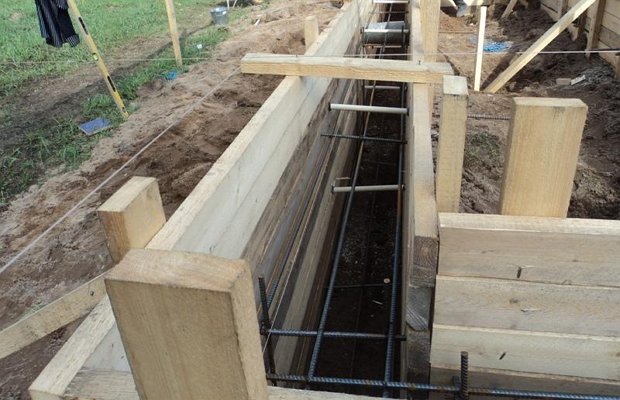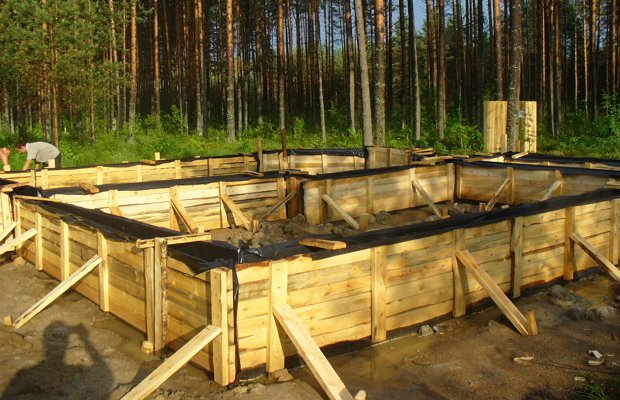Formwork for the foundation - we do it ourselves with a minimum of costs
The formwork for the strip foundation is a special form designed to be filled with concrete. Its installation is carried out immediately after the completion of the trench and the site for the foundation of the building. If desired, it is easy to do it yourself.
1 Basic information about formwork - why is it needed, and what is it?
During the construction of various structures and houses, it is impossible to do without formwork - a constructive form-building element in which the concrete mixture solidifies. With its competent design, you can minimize the cost of erecting a strip foundation and at the same time get a truly reliable and durable underground foundation for any building, from a fence to a residential building.
The formwork is manufactured in two types. It can be removable and non-removable. Removable is most often used in suburban construction for the construction of private houses on a strip foundation. It is easy to make it with your own hands from almost any wooden blocks and boards. The construction of more complex bored columnar foundations involves the use of permanent formwork. Such a structure, as its name implies, remains forever part of the base of the building; it is not removed after the concrete has set.
Nowadays, fixed-type formwork made of expanded polystyrene is in demand (including in private construction). It, firstly, provides the required form to the concrete solution poured into the foundation, and secondly, it performs the function of a high-quality and effective heat insulator.

Nowadays, ready-made formwork is sold in construction stores. They have a number of undoubted advantages:
- high strength;
- absence of errors and inconsistencies of individual parts;
- the ability to choose the material from which they are made (wood, expanded polystyrene, metal).
But ready-made kits cost a lot of money. Therefore, private construction usually uses formwork, which can be done with your own hands at low cost. Such an event is quite laborious. In this case, you will only need to stock up on boards (plywood), ordinary nails and wooden planks in order to build a reliable mold for pouring concrete.
2 Formwork materials - minimum required
For a strip foundation at home, it is recommended to make the shape of interest to us for the concrete composition from plywood or boards. It is made in the form of shields fixed on a base of wooden blocks. The resulting shields are assembled into one structure by means of clamps, slopes and simple ties, and then mounted in a trench for. Here it is important to ensure that the inside of the panel structure is as even and smooth as possible.

The "uneven" side with all the elements for fixing individual parts of the formwork is brought out to the outside. For the manufacture of a collapsible form, plywood sheets of birch or an edged board (it is allowed to work with second-grade material) with a thickness of 2.4 to 3.6 cm are used. so on) - from the remnants of wood materials. It is only necessary to ensure that they are firmly fixed. After using the formwork, take it out.
Subsequently, you can use this form many more times. . To make the process of dismantling it quick and convenient, it is recommended to line the formwork that you made with your own hands with plastic wrap.
3 How to make a simple removable structure yourself?
In practice, the construction of a foundation mold is as follows. First, cut the bars into equal-sized pieces and sharpen one of their sides. Then you need to cut plywood or boards as accurately and correctly as possible - so that they correspond to the geometric parameters of the shields. It is important to tightly fit the elements of the panel structure, trying not to leave even the slightest gaps between them. With due diligence, this stage of do-it-yourself work is quite simple.

- spread the bars on a flat surface, keeping a distance of about 100 cm between them;
- align them carefully along the top edge;
- put plywood (boards) on the bars and fix them with self-tapping screws (fasteners can also be made with ordinary nails).
Pay attention - the hats of the hardware must be inside the self-made panel structure for the strip foundation. If you do the opposite, the points of screws or nails will not allow you to easily remove the formwork after the concrete has set. If you need one that has a certain extension in its lower part, the shields must be resting against the board (it will be the supporting one), and the bars must be cut to the width of the frame. In this case, the latter is allowed not to deepen into the ground.

We continue to do the formwork with our own hands according to the following scheme:
- we stretch a string of nylon between the bars driven into the ground in order to correctly mark the site;
- we dig according to the marking of the ditch of the required depth (it is advisable to fill the trench with a mixture of gravel and sand);
- we put, if necessary, a support board, and then a panel structure (at this stage it is imperative to use a level and a plumb line, which will allow the panels to be placed correctly and evenly).
With a low stability of the shields for the strip foundation, they can be made more reliable. It is not difficult to strengthen the structure with special struts made from cuttings on the outside and bars on the inside. The cut is the same block cut at a 45-degree angle. It is mounted by a bulge between the shield frame and the ground. In fact, you have already managed to build the simplest formwork with your own hands. It is only necessary to put a polyethylene dense film on its walls and bottom (such protection will not allow the cement mixture to evaporate and eliminate the risk of the concrete solution seeping out).
Then the installation of the bar reinforcement for the strip foundation is carried out, the filling of the made form with concrete and the leveling of its surface. There is nothing else to do. It is required to wait for the moment when the concrete mix sets. Dismantling of the formwork is carried out when a small gap appears between the concrete base and the boards. For strip foundations with a minimum of effort, tap with a rubber mallet on the outside of the panel frame.
First of all, you need to dismantle the clamps, slopes and screeds. And only after that, take out all the shields that make up the structure (this must be done in turn - one part of the frame, then the second, and so on). We hope that the installation of the formwork will take place at your place, thanks to our advice, simply and quickly. And you will get a really solid foundation "for the ages."



